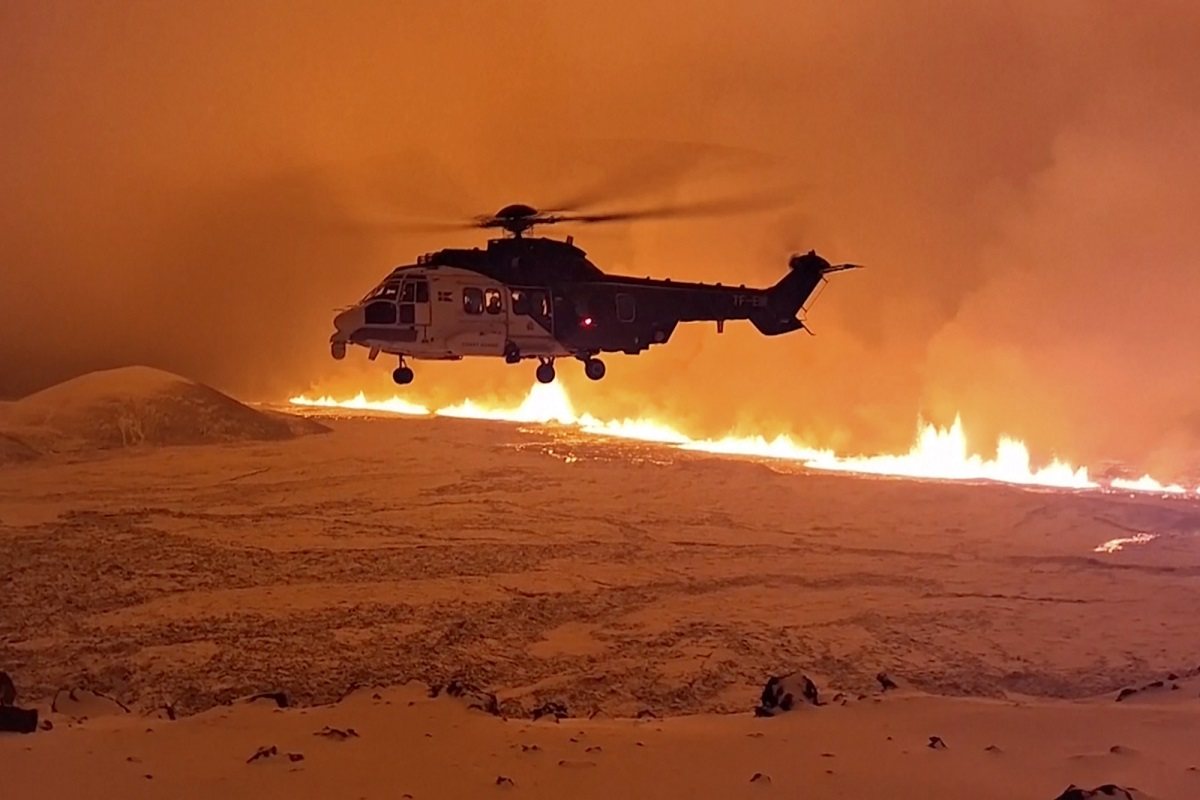
This image made from video provided by the Icelandic Coast Guard shows its helicopter flying near magma running on a hill near Grindavik on Iceland’s Reykjanes Peninsula sometime around late Monday, Dec. 18, or early Tuesday, Dec. 19, 2023.
11:18 JST, December 20, 2023
LONDON (AP) — Scientists anticipated the eruption of a volcano in southwestern Iceland for weeks, so when it happened on Monday night, it was no surprise. The region had been active for more than two years and thousands of small earthquakes rattled the area in recent weeks.
Here is a look at what happened and what may be ahead:
HOW THE ERUPTION UNFOLDED
It started at about 10:20 p.m. local time on Monday north of Grindavik, a fishing town of 3,400 people on the Reykjanes Peninsula. The town is about 50 kilometers (31 miles) southwest of Iceland’s capital, Reykjavik, in an area known broadly as Fagradalsfjall volcano.
First there was a series of small earthquakes. Then lava that’s some 1,200 degrees Celsius (2,192 degrees Fahrenheit) began pouring out of a fissure about 4 kilometers (2.5 miles) long. The Icelandic Meteorological Office estimated that hundreds of cubic meters of lava per second flowed out in the first two hours of the eruption, though the activity had significantly subsided by Tuesday afternoon.
WAS IT UNEXPECTED?
In short, no — scientists had expected the eruption for several weeks and in November, authorities evacuated Grindavik after thousands of small earthquakes shook the area for more than two weeks. Scientists said their monitors showed that a corridor of magma, or semi-molten rock, was spreading toward the town and could reach the surface imminently.
The nearby Blue Lagoon geothermal resort, one of Iceland’s best-known tourist attractions, had to close temporarily as a precaution after a magnitude 4.8 earthquake hit the area last month.
Fagradalsfjall had been dormant for some 6,000 years but it flared to life in March 2021, when hundreds of people flocked to the Reykjanes Peninsula to see spectacular lava flows that lasted for months. The red glow from the lava could be seen from the outskirts of the capital.
WILL THIS ERUPTION AFFECT FLIGHTS?
None of the recent eruptions on the Reykjanes Peninsula caused damage or disruptions to flights, despite the area’s proximity to the country’s main Keflavik Airport. And though Monday’s eruption appears to be larger and more powerful than those in recent years, forecasters and scientists say it’s unlikely to impact air travel.
Many still recall the huge disruptions to international aviation in 2010, when a different Icelandic volcano, the Eyjafjallajokull, spewed giant clouds of ash high into the atmosphere over Europe. Some 100,000 flights were grounded, millions of international travelers stranded and air travel was halted for days because of concerns the fine ash could damage jet engines.
Experts say the location and features of this eruption mean it isn’t expected to produce much ash or cause a similar scale of disruption. AccuWeather, a U.S.-based weather forecasting firm, said Tuesday that initial information shows no ash cloud has yet been observed.
Sam Mitchell, a volcanologist at the University of Bristol, says Monday’s eruption is very different to Eyjafjallajokull’s in 2010, when “a large explosive eruption under a glacier produced a very large cloud and very fine ash in the atmosphere when the wind direction was pointing towards mainland Europe.”
WHAT OTHER IMPACTS COULD THIS ERUPTION HAVE?
Scientists say that there is no current threat that the lava will reach the town of Grindavik or key structures like nearby power plants. The residents from the area have been evacuated and most surrounding roads remain closed.
But the scientists warn the situation could change and that it’s too early to say how long the eruption will last or when local residents could move back into their homes.
“Even though the lava did not erupt into the town of Grindavik or at the nearby power plant and popular tourist destination, the Blue Lagoon, the lava flows are still only a few kilometers away and there is still concern of lavas reaching these key locations,” Mitchell said.
The molten lava flowing above ground can also heighten the risk of poor air quality in the region because of the increased sulfur dioxide content in the air, AccuWeather said. Iceland’s Met Office forecast that gas pollution may be detected in the area of Reykjavik later Tuesday or Wednesday.
One volcanologist, Ármann Höskuldsson, told Iceland’s state broadcaster RUV that he expected the eruption could last from a week to 10 days. “If everything is normal, this will subside in the afternoon tomorrow,” he said.
HOW COMMON ARE VOLCANIC ERUPTIONS IN ICELAND?
Iceland is one of Earth’s most volcanically active areas, with 32 active volcanic sites. It averages an eruption every four to five years — though the frequency has increased closer to every 12 months since 2021.
The country sits on top of a volcanic hotspot and what’s called the mid-Atlantic ridge, a huge crack in the ocean floor caused by the separation of the North American and Eurasian tectonic plates. As the plates pull apart, new magma rises up to fill the gaps, triggering earthquakes and volcanic activity.
One of the country’s largest active volcanoes is Katla, which is closely watched because it lies under thick glacial ice, meaning that any eruption could melt the ice and trigger widespread flooding. Katla last erupted in 1918, and that eruption lasted almost a month, starving crops of sunlight and killing some livestock.
"News Services" POPULAR ARTICLE
-

American Playwright Jeremy O. Harris Arrested in Japan on Alleged Drug Smuggling
-

Japan’s Nikkei Stock Average as JGB Yields, Yen Rise on Rate-Hike Bets
-

Japan’s Nikkei Stock Average Licks Wounds after Selloff Sparked by BOJ Hike Bets (UPDATE 1)
-

Japanese Bond Yields Zoom, Stocks Slide as Rate Hike Looms
-

Japan’s Nikkei Stock Average Buoyed by Stable Yen; SoftBank’s Slide Caps Gains (UPDATE 1)
JN ACCESS RANKING
-

Keidanren Chairman Yoshinobu Tsutsui Visits Kashiwazaki-Kariwa Nuclear Power Plant; Inspects New Emergency Safety System
-

Imports of Rare Earths from China Facing Delays, May Be Caused by Deterioration of Japan-China Relations
-

University of Tokyo Professor Discusses Japanese Economic Security in Interview Ahead of Forum
-

Japan Pulls out of Vietnam Nuclear Project, Complicating Hanoi’s Power Plans
-

Govt Aims to Expand NISA Program Lineup, Abolish Age Restriction


























